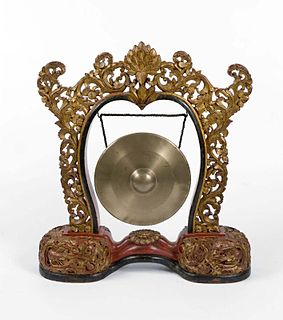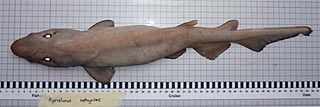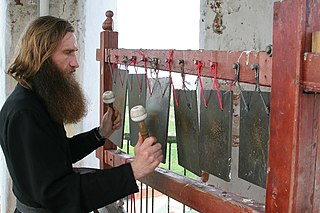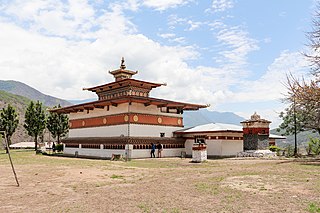
Adobe is a building material made from earth and organic materials, adobe is Spanish for mudbrick. In some English-speaking regions of Spanish heritage, such as the Southwestern United States, the term is used to refer to any kind of earthen construction, or various architectural styles like Pueblo Revival or Territorial Revival. Most adobe buildings are similar in appearance to cob and rammed earth buildings. Adobe is among the earliest building materials, and is used throughout the world.

A gong is a percussion instrument originating in East Asia and Southeast Asia. Gongs are a flat, circular metal disc that is typically struck with a mallet. They can be small or large in size, and tuned or untuned.

A tent is a shelter consisting of sheets of fabric or other material draped over, attached to a frame of poles or attached to a supporting rope. While smaller tents may be free-standing or attached to the ground, large tents are usually anchored using guy ropes tied to stakes or tent pegs. First used as portable homes by nomads, tents are now more often used for recreational camping and as temporary shelters.

A wooden fish, also known as a Chinese temple block, wooden bell, or muyu, is a type of woodblock that originated from East Asia that is used by monks and lay people in the Mahayana tradition of Buddhism. They are used by Buddhist ceremonies in China, Korea, Japan, and other Asian countries. They may be referred to as a Chinese block, Korean block or, rarely, as a skull.

The cowbell is an idiophone hand percussion instrument used in various styles of music, such as Latin and rock. It is named after the similar bell used by herdsmen to keep track of the whereabouts of cows. The instrument initially and traditionally has been metallic; however, contemporarily, some variants are made of synthetic materials.

The Tinkertoy Construction Set is a toy construction set for children. It was designed in 1914—six years after the Frank Hornby's Meccano sets—by Charles H. Pajeau, who formed the Toy Tinker Company in Evanston, Illinois to manufacture them. Pajeau, a stonemason, designed the toy after seeing children play with sticks and empty spools of thread. Pajeau partnered with Robert Pettit and Gordon Tinker to market a toy that would allow and inspire children to use their imaginations. After an initially-slow start, over a million were sold.

A barrel or cask is a hollow cylindrical container with a bulging center, longer than it is wide. They are traditionally made of wooden staves and bound by wooden or metal hoops. The word vat is often used for large containers for liquids, usually alcoholic beverages; a small barrel or cask is known as a keg.

A cooper is a person trained to make wooden casks, barrels, vats, buckets, tubs, troughs and other similar containers from timber staves that were usually heated or steamed to make them pliable.

A bell is a directly struck idiophone percussion instrument. Most bells have the shape of a hollow cup that when struck vibrates in a single strong strike tone, with its sides forming an efficient resonator. The strike may be made by an internal "clapper" or "uvula", an external hammer, or—in small bells—by a small loose sphere enclosed within the body of the bell.

The pocket trumpet is a B♭ trumpet that is constructed with the tubing wound into a much smaller coil than a standard trumpet, generally with a smaller diameter bell. It is not a standard instrument in a concert band or orchestra and is generally regarded as a novelty. It has been used by soloists in jazz or other ensembles to add flair and variety.

The nail violin is a musical instrument which was invented by German violinist Johann Wilde in 1740. The instrument consists of a semicircular wooden soundboard, approximately 1.5 feet (46 cm) by 1 foot (30 cm) in size, with iron or brass nails of different lengths arranged to produce a chromatic scale when bowed.

Goshavank is a 12th- or 13th-century Armenian monastery located in the village of Gosh in the Tavush Province of Armenia. The impressive monastery which has remained in relatively good condition also houses one of the world's finest examples of a khachkar.

The white ghost catshark is a shark of the catshark family Scyliorhinidae found in deep water in the northeast Atlantic between latitudes 57°N and 58°N. A deep-water catshark known from the eastern North Atlantic from depths of 1,014 to 1,800 m, it is known from only a limited number of specimens. It reaches a maximum of 54 cm or 1.7 ft total length which is a medium size for the Apristurus genus.
Traditional Thai musical instruments are the musical instruments used in the traditional and classical music of Thailand. They comprise a wide range of wind, string, and percussion instruments played by both the Thai majority as well as the nation's ethnic minorities.

The semantron or semandron, or semanterion (σημαντήριον), also called a xylon (ξύλον) is a percussion instrument used in monasteries to summon the monastics to prayer or at the start of a procession.

Chimi Lhakhang, also known as Chime Lhakhang or Monastery or temple, is a Buddhist monastery in Punakha District, Bhutan. Located near Lobesa, it stands on a round hillock and was built in 1499 by the 14th Drukpa hierarch, Ngawang Choegyel, after the site was blessed by the "Divine Madman" the maverick saint Drukpa Kunley (1455–1529) who built a chorten on the site.

Snow snake is a Native American winter sport traditionally played by many tribes in the Great Lakes region, including the Ojibwe, Sioux, Wyandotte, Oneida and other Haudenosaunee people.

Pelsi tsässon is a small Seto chapel situated in Pelsi village, Meremäe municipality in Võru County in Estonia.
The segankuru is a bowed trough zither, bar zither or musical bow, a string instrument found in Botswana and other areas of South Africa, and found under many names. It consists of a wooden body attached to a tin can resonator, with a single metal string played with a bow. The instruments main role is for self or group entertainment for young men, while herding cattle, etc.

The 20 cm naval rocket launcher was a rocket artillery system used by the Imperial Japanese Navy in the final stages of World War II.


















